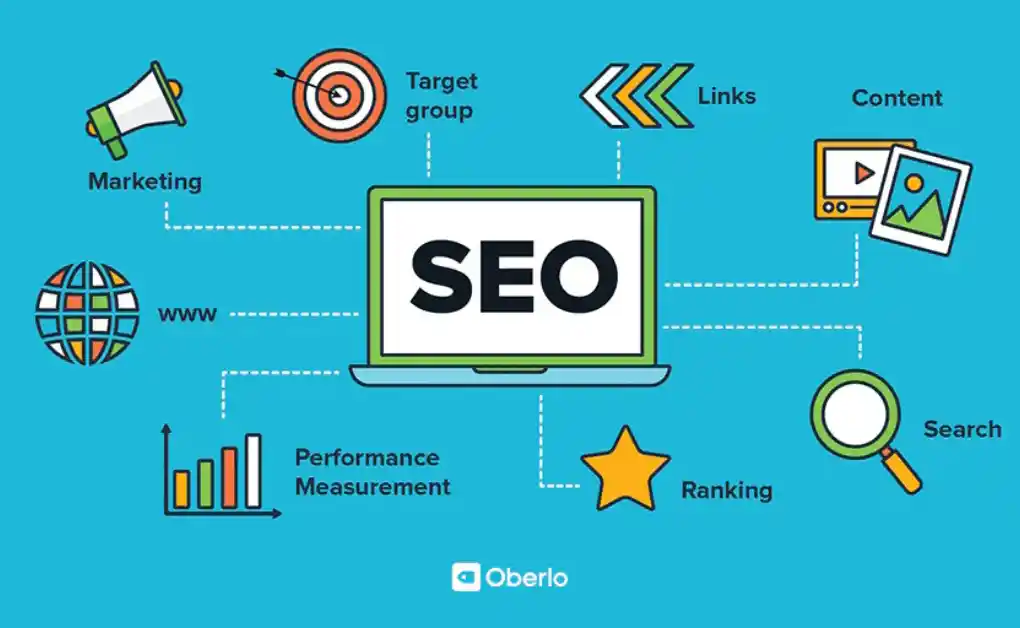What is SEO?
SEO stands for Search Engine Optimization. It involves strategies and practices designed to improve your website’s visibility on search engines. Unlike paid advertising, SEO focuses on organic (non-paid) search results.
For example, if you search for “digital marketing tips,” the websites listed below the ads are ranking due to their SEO efforts. Higher rankings translate to more traffic, better visibility, and increased authority in your industry.

Why SEO Matters
The importance of SEO lies in its ability to:
- Increase Website Traffic: By ranking higher, you attract more visitors.
- Build Credibility: Websites on the first page of search results are often perceived as more trustworthy.
- Enhance User Experience: Good SEO practices improve website usability and speed.
- Provide Long-Term Benefits: Unlike paid ads, SEO efforts continue to yield results over time.
Core Elements of SEO
SEO is an umbrella term encompassing several elements. Let’s break them down:
1. On-Page SEO
On-page SEO involves optimizing individual web pages to rank higher. This includes:
- High-Quality Content: Content is the heart of SEO. Create content that is informative, engaging, and addresses the needs of your audience. Use headings, bullet points, and visuals to make it digestible. For instance, a blog on “Top 10 SEO Tools” should provide in-depth insights, comparisons, and actionable tips.
- Keyword Placement: Keywords should flow naturally in your content, titles, headers, and meta tags. Avoid overstuffing keywords; instead, strategically place them in a way that aligns with user intent.
- Title Tags and Meta Descriptions: Titles should grab attention and incorporate primary keywords. For example, “Best Practices for SEO: A Comprehensive Guide.” Meta descriptions, meanwhile, act as summaries and should entice users to click by highlighting the content’s value.
- Internal Links: Link to related content within your website to guide users and enhance crawlability. For example, link a blog about “SEO Tools” to another about “Keyword Research.”
2. Off-Page SEO
This focuses on external factors, like building backlinks and increasing your domain authority:
- Backlink Quality: Earn backlinks from reputable websites in your niche. For example, a digital marketing blog linked by Forbes signals authority to search engines.
- Social Signals: Actively engage on social media platforms. Likes, shares, and comments indicate relevance and widen your reach.
- Brand Mentions: Even without links, mentions on reputable sites or platforms enhance brand visibility and credibility.
3. Technical SEO
Technical SEO ensures search engines can crawl and index your site effectively:
- Website Speed: Pages should load within three seconds. Use tools like Google PageSpeed Insights to optimize loading times by compressing images and enabling browser caching.
- Mobile Optimization: Ensure your site is mobile-friendly. Use responsive designs to provide seamless navigation across devices.
- Sitemap and Robots.txt: Provide search engines with clear guidelines on which pages to crawl and index. Regularly update your XML sitemap and ensure robots.txt files are error-free.
How Search Engines Work
Search engines use bots to crawl billions of web pages, collecting information to build an index. When a user searches for something, the search engine analyzes its index and displays the most relevant results using algorithms. These algorithms consider factors like:
- Relevance: Does the content match the search query?
- Authority: Is the website credible and trustworthy?
- User Experience: How well does the page engage users?
Mastering SEO Elements
Content: The Foundation of SEO
Content is king in the world of SEO. Follow these principles:
- Quality Over Quantity: Create detailed, in-depth content that answers users’ questions thoroughly. A blog about “SEO Trends” should include data, expert opinions, and actionable steps.
- Intent Alignment: Determine if your audience seeks information, a solution, or a product. Tailor content to meet their specific needs.
- Freshness: Update content regularly with the latest trends, data, and examples. For instance, refresh an article on “SEO Tools” annually to include new software.

Keyword Research
Effective keyword research identifies the terms your audience is searching for:
- Use tools like Google Keyword Planner or SEMrush to discover high-value keywords.
- Prioritize long-tail keywords that align closely with user intent, like “best SEO tools for small businesses.”
- Integrate keywords naturally within your content to maintain readability and relevance.
HTML Optimization
Optimize your HTML elements to boost rankings:
- Title Tags: Write concise, descriptive titles that incorporate your primary keyword.
- Meta Descriptions: Craft summaries that highlight the page’s value and include a call-to-action.
- Alt Text for Images: Use descriptive alt text to improve image accessibility and SEO. For instance, “a graph showing website traffic increase after SEO improvements.”
Site Structure
A well-organized site is easy to navigate for both users and search engines:
- Hierarchy: Organize pages under clear categories. For example, a “SEO” category could include subcategories like “On-Page SEO” and “Technical SEO.”
- Internal Linking: Ensure related pages connect to guide users through your content.
- URL Structure: Keep URLs clean and descriptive, like “example.com/seo-best-practices.”
E-E-A-T: Experience, Expertise, Authority, Trustworthiness
Google emphasizes E-E-A-T in determining content quality:
- Experience: Showcase real-world knowledge or experience through case studies and examples.
- Expertise: Highlight credentials, certifications, and affiliations.
- Authority: Gain backlinks from respected sources in your industry.
- Trustworthiness: Use secure connections (HTTPS) and accurate information.
Links: The Backbone of SEO
Build both internal and external links:
- Internal Links: Create connections within your site to improve navigation and distribute authority.
- Backlinks: Gain high-quality links through guest posts, partnerships, or outreach efforts.
Local SEO
Local SEO is crucial for businesses targeting specific areas:
- Google Business Profile: Optimize your profile with accurate information and images.
- Consistent NAP: Use the same Name, Address, and Phone details across platforms.
- Customer Reviews: Encourage satisfied customers to leave reviews on Google and Yelp.
Adapting to Google Algorithm Updates
Google frequently updates its algorithms to improve user experience. Significant updates include:
- Helpful Content Update: Focused on rewarding high-quality, user-centric content.
- Core Web Vitals: Prioritizes site speed, interactivity, and stability.
Stay informed by:
- Monitoring changes via tools like Moz or Ahrefs.
- Following industry blogs and Google’s Search Central.
AI and the Future of SEO
Artificial intelligence is transforming SEO through features like AI-generated snippets and Search Generative Experiences (SGE). To adapt:
- Create authoritative, in-depth content that AI references in summaries.
- Optimize for voice and conversational searches.
- Embrace emerging technologies to stay competitive.
Conclusion
SEO is a dynamic, multifaceted field essential for digital success. By focusing on quality content, technical excellence, and adapting to changes, you can achieve sustained growth and visibility. Remember, SEO is a marathon, not a sprint—stay consistent, monitor progress, and refine your strategy over time.
FAQS
1. What is SEO?
SEO (Search Engine Optimization) is the process of optimizing your website to improve its ranking in search engine results. The goal is to increase organic traffic and visibility.
2. Why is SEO important for my business?
SEO helps your website appear in search results when users search for relevant terms. Higher visibility increases traffic, brand awareness, and the likelihood of attracting customers.
3. How long does it take to see results from SEO?
SEO is a long-term strategy. It typically takes 3-6 months to start seeing significant improvements, but the timeline varies based on competition and your website’s current status.
4. What factors affect SEO rankings?
Key factors include content quality, keyword optimization, website structure, mobile-friendliness, page load speed, backlinks, and user experience.
5. What is keyword research, and why is it important?
Keyword research involves identifying the words and phrases people use to search for your products or services. Targeting the right keywords helps you reach your audience effectively.


